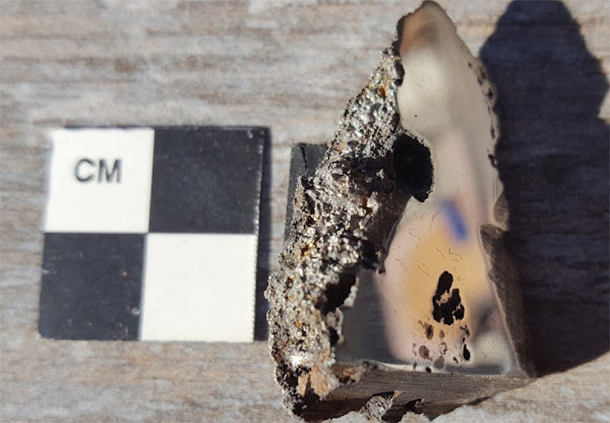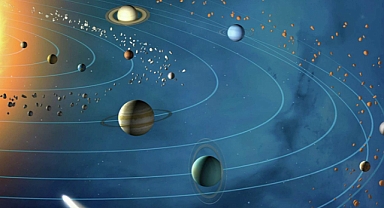The latter honors Lindy Elkins-Tanton, a leading planetary scientist. While a third mineral is under review, further studies might be hindered as the meteorite has reportedly been moved to China for commercial purposes. Two newly discovered minerals, previously unseen on Earth, have been identified in a massive meteorite that crashed in Somalia in 2020. Researchers at the University of Alberta analyzed a small fragment of the meteorite and made this groundbreaking discovery. The 15-ton El Ali meteorite found in Somalia is the ninth-largest meteorite ever found. Image credit: University of AlbertaThough tons of cosmic debris enter Earth’s atmosphere daily, most burn up before reaching the surface due to the intense friction. However, the meteorite that landed near El Ali in Somalia is an extraordinary exception. Weighing an impressive 16.5 tons (15 tonnes), it is the ninth-largest meteorite ever recorded.A 2.5-ounce (70-gram) sample of the celestial rock sent to the University of Alberta revealed two minerals entirely new to science. Chris Herd, a professor in the Department of Earth & Atmospheric Sciences and curator of the university’s Meteorite Collection, explained, “The discovery of new minerals signifies unique geological and chemical conditions not previously observed, making this finding incredibly exciting.”
The 15-ton El Ali meteorite found in Somalia is the ninth-largest meteorite ever found. Image credit: University of AlbertaThough tons of cosmic debris enter Earth’s atmosphere daily, most burn up before reaching the surface due to the intense friction. However, the meteorite that landed near El Ali in Somalia is an extraordinary exception. Weighing an impressive 16.5 tons (15 tonnes), it is the ninth-largest meteorite ever recorded.A 2.5-ounce (70-gram) sample of the celestial rock sent to the University of Alberta revealed two minerals entirely new to science. Chris Herd, a professor in the Department of Earth & Atmospheric Sciences and curator of the university’s Meteorite Collection, explained, “The discovery of new minerals signifies unique geological and chemical conditions not previously observed, making this finding incredibly exciting.” The El Ali meteorite is big, but it is dwarfed by the 60-tonne, 2.7 m (8.9 ft) long Hoba meteorite in Namibia, the largest known intact meteorite. Image credit: CalipsNamed elaliite and elkinstantonite, the minerals were identified using advanced tools like the university's Electron Microprobe Laboratory. The first mineral derives its name from the El Ali meteorite itself. The second honors Lindy Elkins-Tanton, a prominent planetary scientist and principal investigator for NASA’s Psyche mission, which aims to study the metallic asteroid Psyche.“These discoveries help us understand how planetary cores form, as iron meteorites are the closest analogs we have,” Herd noted. Interestingly, a third mineral might also be new, pending further analysis. The meteorite could harbor even more undiscovered substances, provided additional samples can be secured.
The El Ali meteorite is big, but it is dwarfed by the 60-tonne, 2.7 m (8.9 ft) long Hoba meteorite in Namibia, the largest known intact meteorite. Image credit: CalipsNamed elaliite and elkinstantonite, the minerals were identified using advanced tools like the university's Electron Microprobe Laboratory. The first mineral derives its name from the El Ali meteorite itself. The second honors Lindy Elkins-Tanton, a prominent planetary scientist and principal investigator for NASA’s Psyche mission, which aims to study the metallic asteroid Psyche.“These discoveries help us understand how planetary cores form, as iron meteorites are the closest analogs we have,” Herd noted. Interestingly, a third mineral might also be new, pending further analysis. The meteorite could harbor even more undiscovered substances, provided additional samples can be secured. Scientists would need a bigger piece of the meteorite to be able to carry on researching the meteorite’s composition. Image credit: University of AlbertaUnfortunately, future research faces challenges. Reports suggest the El Ali meteorite has been transported to China for sale, leaving its scientific availability uncertain. Whether potential buyers will allow further sampling remains to be seen.
Scientists would need a bigger piece of the meteorite to be able to carry on researching the meteorite’s composition. Image credit: University of AlbertaUnfortunately, future research faces challenges. Reports suggest the El Ali meteorite has been transported to China for sale, leaving its scientific availability uncertain. Whether potential buyers will allow further sampling remains to be seen.
 The 15-ton El Ali meteorite found in Somalia is the ninth-largest meteorite ever found. Image credit: University of AlbertaThough tons of cosmic debris enter Earth’s atmosphere daily, most burn up before reaching the surface due to the intense friction. However, the meteorite that landed near El Ali in Somalia is an extraordinary exception. Weighing an impressive 16.5 tons (15 tonnes), it is the ninth-largest meteorite ever recorded.A 2.5-ounce (70-gram) sample of the celestial rock sent to the University of Alberta revealed two minerals entirely new to science. Chris Herd, a professor in the Department of Earth & Atmospheric Sciences and curator of the university’s Meteorite Collection, explained, “The discovery of new minerals signifies unique geological and chemical conditions not previously observed, making this finding incredibly exciting.”
The 15-ton El Ali meteorite found in Somalia is the ninth-largest meteorite ever found. Image credit: University of AlbertaThough tons of cosmic debris enter Earth’s atmosphere daily, most burn up before reaching the surface due to the intense friction. However, the meteorite that landed near El Ali in Somalia is an extraordinary exception. Weighing an impressive 16.5 tons (15 tonnes), it is the ninth-largest meteorite ever recorded.A 2.5-ounce (70-gram) sample of the celestial rock sent to the University of Alberta revealed two minerals entirely new to science. Chris Herd, a professor in the Department of Earth & Atmospheric Sciences and curator of the university’s Meteorite Collection, explained, “The discovery of new minerals signifies unique geological and chemical conditions not previously observed, making this finding incredibly exciting.” The El Ali meteorite is big, but it is dwarfed by the 60-tonne, 2.7 m (8.9 ft) long Hoba meteorite in Namibia, the largest known intact meteorite. Image credit: CalipsNamed elaliite and elkinstantonite, the minerals were identified using advanced tools like the university's Electron Microprobe Laboratory. The first mineral derives its name from the El Ali meteorite itself. The second honors Lindy Elkins-Tanton, a prominent planetary scientist and principal investigator for NASA’s Psyche mission, which aims to study the metallic asteroid Psyche.“These discoveries help us understand how planetary cores form, as iron meteorites are the closest analogs we have,” Herd noted. Interestingly, a third mineral might also be new, pending further analysis. The meteorite could harbor even more undiscovered substances, provided additional samples can be secured.
The El Ali meteorite is big, but it is dwarfed by the 60-tonne, 2.7 m (8.9 ft) long Hoba meteorite in Namibia, the largest known intact meteorite. Image credit: CalipsNamed elaliite and elkinstantonite, the minerals were identified using advanced tools like the university's Electron Microprobe Laboratory. The first mineral derives its name from the El Ali meteorite itself. The second honors Lindy Elkins-Tanton, a prominent planetary scientist and principal investigator for NASA’s Psyche mission, which aims to study the metallic asteroid Psyche.“These discoveries help us understand how planetary cores form, as iron meteorites are the closest analogs we have,” Herd noted. Interestingly, a third mineral might also be new, pending further analysis. The meteorite could harbor even more undiscovered substances, provided additional samples can be secured. Scientists would need a bigger piece of the meteorite to be able to carry on researching the meteorite’s composition. Image credit: University of AlbertaUnfortunately, future research faces challenges. Reports suggest the El Ali meteorite has been transported to China for sale, leaving its scientific availability uncertain. Whether potential buyers will allow further sampling remains to be seen.
Scientists would need a bigger piece of the meteorite to be able to carry on researching the meteorite’s composition. Image credit: University of AlbertaUnfortunately, future research faces challenges. Reports suggest the El Ali meteorite has been transported to China for sale, leaving its scientific availability uncertain. Whether potential buyers will allow further sampling remains to be seen. 








